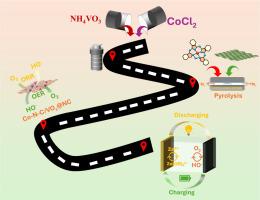Oxygen-deficient VOx integrated cobalt‑nitrogen codoped carbon emerging as a sustainable bifunctional catalyst for efficient zinc–air batteries
IF 9.2
2区 工程技术
Q1 ENERGY & FUELS
引用次数: 0
Abstract
Improving zinc-air batteries (ZABs) appeals for materials that hasten the two primary electrochemical reactions, especially OER and ORR. There has been significant efforts to construct non-precious metal dual functional catalysts as noble-metal catalyst alternatives. However, for these catalysts, reaching the performance levels required for ZAB commercialisation still remains an elusive goal. In this work, an interconnected oxygen-deficient vanadium oxide (VOx) in proximity to (Co/Fe)-N-C sites evolving as a sustainable and efficient catalyst for ZABs has been presented. Among the synthesized materials, Co-N-C/VOx@NC demonstrates superior bifunctional ORR/OER activity at ZAB air-electrode evidenced by its lower voltage gap between ORR and OER compared to Fe-N-C/VOx@NC. According to theoretical simulations, the spectacular bifunctional performance of Co-N-C/VOx@NC was attributed to escalated charge-transfer across the active sites and favourable d-band centre alignment which improves the adsorption energy of oxygenated intermediates facilitating the reaction kinetics. Under practical ZABs operating conditions, Co-N-C/VOx@NC air electrode achieved a peak power density of 155 mW cm−2, outperforming other catalysts and furthermore yielding a specific capacity of 869.2 mAh g−1, exceeding that of PtRu/C by 1.8 % and Fe-N-C/VOx@NC by 22.5 % under similar operating conditions. Co-N-C/VOx@NC batteries performed well after 35 h of uninterrupted operation at 5 mA cm−2, unlike PtRu/C batteries, which degraded after 600 cycles.

缺氧VOx集成钴氮共掺杂碳正在成为高效锌空气电池的可持续双功能催化剂
改进锌空气电池(ZABs)需要加速两种主要电化学反应的材料,特别是OER和ORR。构建非贵金属双功能催化剂作为贵金属催化剂的替代品已经取得了重大进展。然而,对于这些催化剂来说,达到ZAB商业化所需的性能水平仍然是一个难以实现的目标。在这项工作中,提出了在(Co/Fe)-N-C位点附近相互连接的缺氧氧化钒(VOx),作为ZABs的可持续和高效催化剂。在合成的材料中,Co-N-C/VOx@NC在ZAB空气电极上表现出更好的双功能ORR/OER活性,与Fe-N-C/VOx@NC相比,其ORR和OER之间的电压间隙更小。根据理论模拟,Co-N-C/VOx@NC的双功能性能归因于活性位点的电荷转移升级和有利的d波段中心对准,这提高了氧化中间体的吸附能,促进了反应动力学。在ZABs实际操作条件下,Co-N-C/VOx@NC空气电极的峰值功率密度为155 mW cm - 2,优于其他催化剂,比容量为869.2 mAh g - 1,比PtRu/C和Fe-N-C/VOx@NC分别高出1.8%和22.5%。Co-N-C/VOx@NC电池在5ma cm - 2不间断运行35小时后表现良好,而PtRu/C电池在600次循环后就会退化。
本文章由计算机程序翻译,如有差异,请以英文原文为准。
求助全文
约1分钟内获得全文
求助全文
来源期刊

Sustainable Materials and Technologies
Energy-Renewable Energy, Sustainability and the Environment
CiteScore
13.40
自引率
4.20%
发文量
158
审稿时长
45 days
期刊介绍:
Sustainable Materials and Technologies (SM&T), an international, cross-disciplinary, fully open access journal published by Elsevier, focuses on original full-length research articles and reviews. It covers applied or fundamental science of nano-, micro-, meso-, and macro-scale aspects of materials and technologies for sustainable development. SM&T gives special attention to contributions that bridge the knowledge gap between materials and system designs.
 求助内容:
求助内容: 应助结果提醒方式:
应助结果提醒方式:


